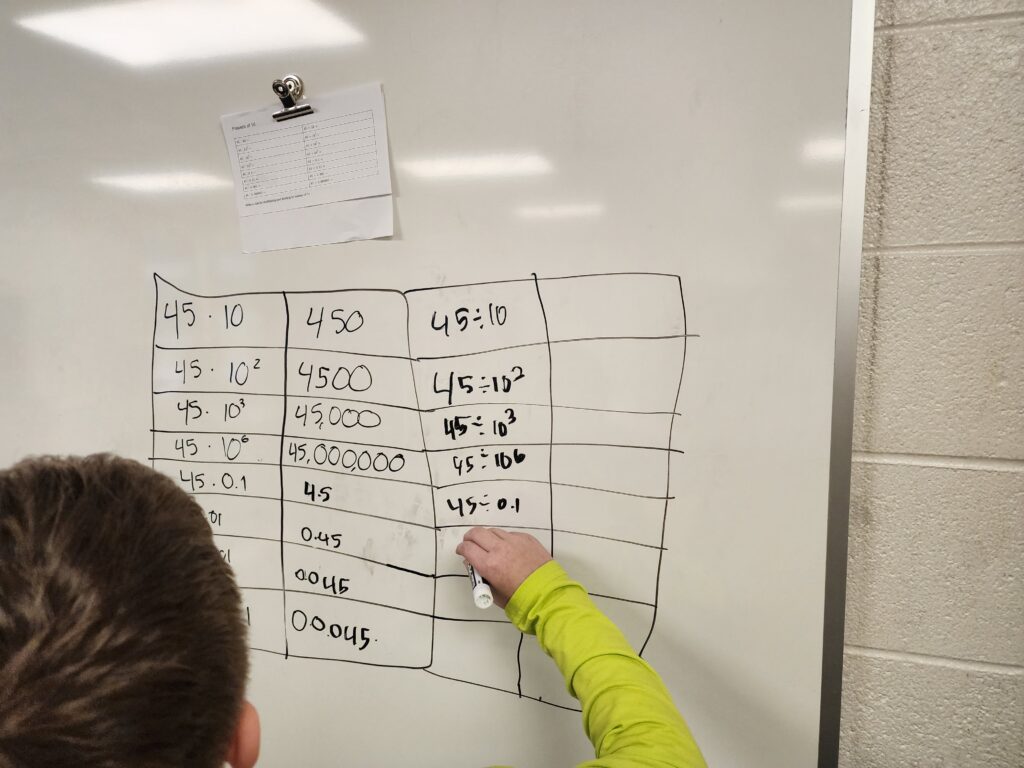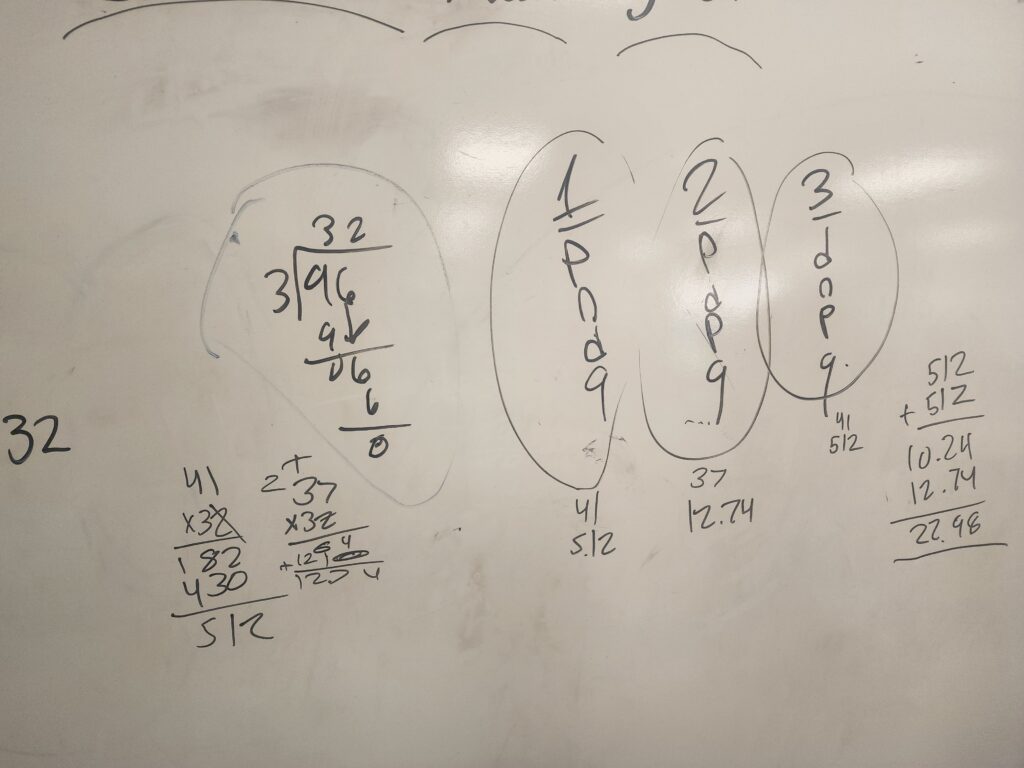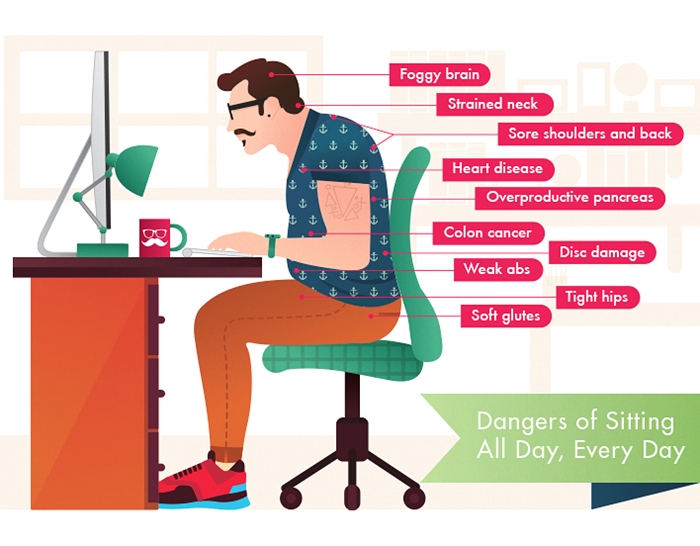First of all, my 6th grade students love working at boards (Vertical Non Permanent Surfaces). They ask me if we are working at boards EVERY SINGLE DAY. That alone is a powerful win in my math class. They would rather work collaboratively to solve problems than listen to boring notes from me. This is 100% in line with my core philosophy: whoever is doing is learning; students thinking rather than listening. Although this post is written from the perspective of the math classroom, boards can be used for formative assessment in any classroom and content area.
One of the exciting things that I have learned is how helpful board work is for me to formatively assess students’ understanding and misunderstandings in real time.
The Numbers
The first advantage of boards for formative assessment is that there are less numbers of places for me to check on. With a class of 30 students, there is not enough time to individually check on each student in an hour long class and provide adequate support. At best it takes me most of the work time to check in with each student, leaving some kids without coaching until the end of period when I finally get to them.
With partner work, there are still too many groups to check on quickly with up to 15 pairs. I can easily get bogged down with a couple of pairs and neglect others. Using groups of 3 at vertical boards, I have a maximum of 10 groups to check. This is more manageable for a single teacher. With boards I assess the entire class by making one lap around the room glancing at each group’s progress before talking to any students. This allows me to quickly assess which groups are on the right track and which may need my support in less than two minutes.
The Visibility
Secondly, quiet students don’t slip through the cracks with board work. When students work alone or even in pairs on practice problems at their tables, I am mostly dependent on them to ask for help when they need it. I always provide answer keys so that students can self-assess and admonish them to seek help when needed, but there are always a segment of students who will quietly struggle without seeking assistance. Whether because of shyness, apathy, or fear of “looking dumb” these students will rarely ask for help.
With seat work, I walk around the room and peek over shoulders to verify that students are on the right path, but this proves time-consuming and often difficult to see student work without interrupting their flow. I often need them to move their hands or stop working so that I can view their work. Some of my students write very small and I cannot read it without taking their paper from them.
But with board work, all student work is clearly visible with my quick stroll around the perimeter of the class. No student can hide from me, not even the shy ones. Students naturally write larger on the boards than on paper so my old eyes can clearly see their work. There is also a quiet buzz around the room so a shy student does not feel singled out when I question them.
I have found boards to be the single most effective formative assessment in my math classroom.
The Work
What am I assessing when I look at student board work? I am looking for common misunderstandings and creative solutions. I don’t just check right or wrong answers, but analyze student thinking and their problem-solving approaches.
- Do they have a different way of approaching the problem than I would?
- Are there conceptional errors?
- Have they forgotten about past math ideas that would help them now?
- How can I link previous knowledge to current problems?
- Are they checking each other’s work?
- Can they explain their thinking?
- Can they apply their method to a new problem or situation?
The Support
After my quick assessment stroll, how do I address what I observe? When I see a common mistake among many groups, I use a call and response to stop and address the whole class immediately. I “teach” from wherever I am in the room. If it is something minor, students stay at their stations and just listen.
Sometimes I gather the class all around one group’s work to see a unique solution. Other times I might challenge them to find the error in a group’s thinking. Since we have a culture of sharing our attempts at problem solving, there is no embarrassment at looking at partial solutions or imperfect thinking.
Another approach I use is to stop and ask a group to explain their thinking. We can have a conversation about their work and I can push back on misconceptions or give hints as needed to connect their thinking to new or old concepts. I try to use questioning to guide them to figure out their mistakes in computations or challenge their thinking.
Another strategy is to teach a mini-lesson (5 minute lecture) to a specific group or multiple groups during board work. The rest of the class is busy working and I have the undivided attention of the 2-3 students in the group. I have found this to a thousand times more helpful than whole class instruction. The small group is actually listening and you are addressing their specific ideas based on their current work.
However you choose to use board work, I have found it to be the fastest and clearest window into student thinking. How do you assess student board work? What support strategies do you use?
Note: this post is a reflection on my implementation of the Thinking Classroom book by Peter Liljedahl. I have not fully implemented all of his ideas but are playing with the philosophy in my room.
Learn with me!
Board work is just one of the strategies that I use in my classroom. If you are interested in how to implement PBL and SEL to build self sufficient learners, I would love to have a conversation on how I can help. I am now scheduling workshops and book studies for spring and summer. Check out my workshop page or drop me an email at mikejkaechele@gmail.com. I would love to chat and co-plan meaningful PD for the educators at your school.
Pulse of PBL




